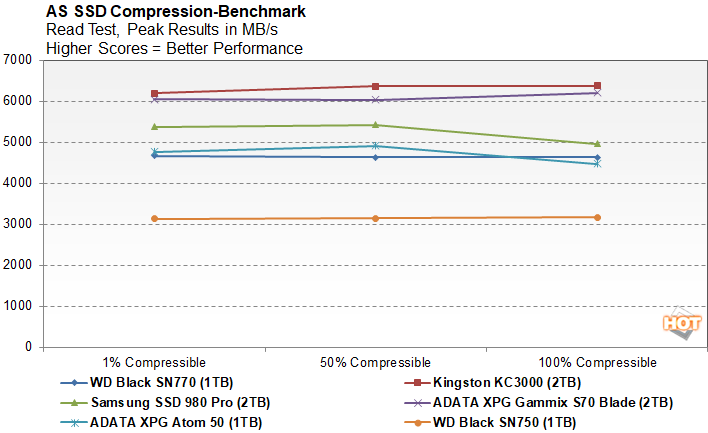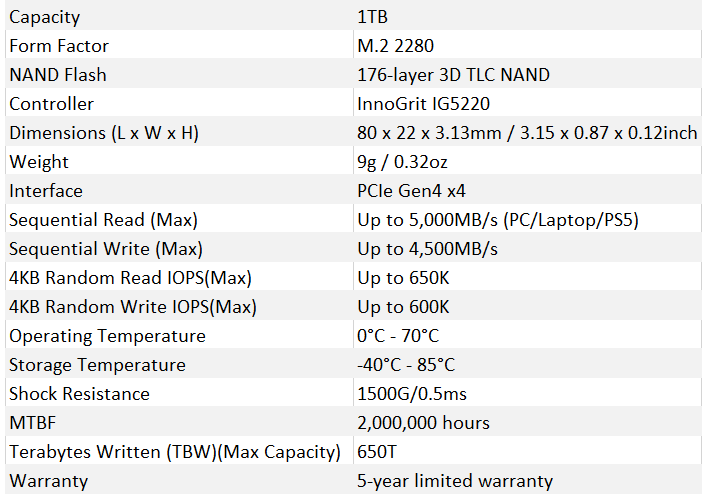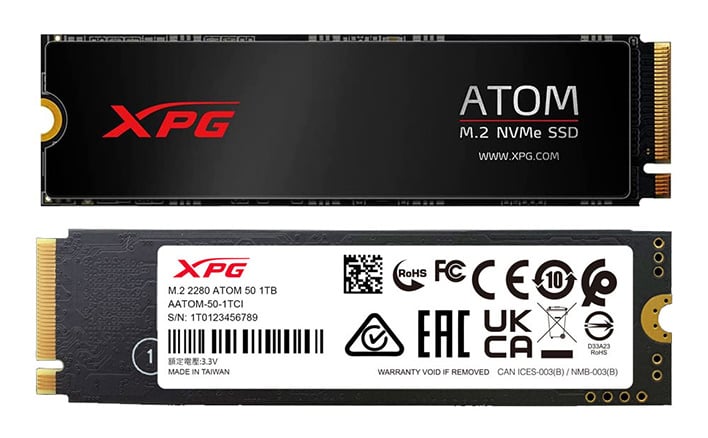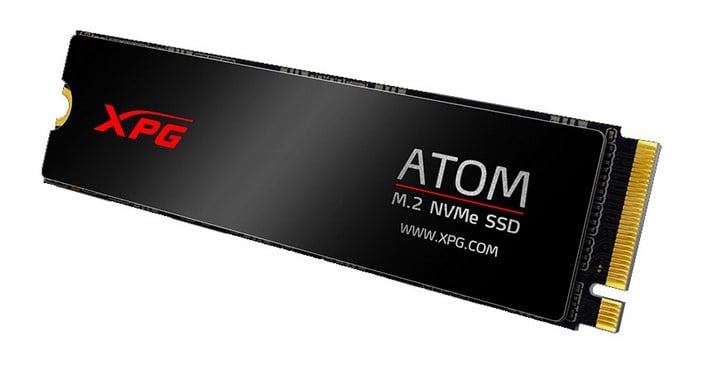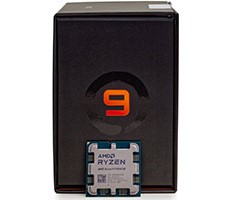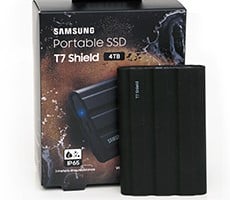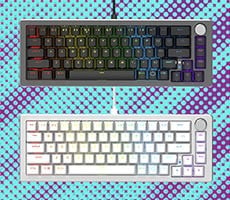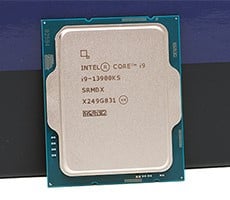ADATA XPG Atom 50 Review: A Speedy Gen 4 SSD For Gamers
Take a look at the ADATA XPG Atom 50’s main features and specifications below. Then we’ll dig in with some benchmarks on the pages ahead to see how she performs, and if it’s worth springing for one of these more affordable solid state drives in light of the many other excellent offerings currently on the market...
ADATA XPG Atom 50 Specifications And Features
Just like most other M.2 drives currently on the market, the ADATA XPG Atom 50 SSD uses the common M.2 2280 (80mm) "gumstick" form factor. And like many of ADATA’s other XPG-branded SSDs, the Atom 50 utilizes an attractive, dark-colored PCB with components packing only one side of the board. One side is masked by a sticker and the other, while exposed right out of box, will be masked by the included heat-spreader or your motherboard’s integrated M.2 cooling hardware.
Powering the ADATA XPG Atom 50 is an InnoGrit IG5220 controller, that’s paired to Micron's 176-Layer 3D TLC NAND Flash memory. The drive features a PCIe Gen 4 x4 interface and support for the NVMe 1.4 specification.
The ADATA XPG Atom 50’s sequential transfers are rated for up to 5GB/s per second reads and 4.5GB/s writes, respectively, when used with a PC, with up to 5GB/s transfers in a PS5. Because this drive packs only a basic, flat heat-spreader, its form factor is a perfect fit for a PlayStation 5 storage upgrade. This particular drive’s endurance rating is 650TBW, and it is currently offered only in a 1TB capacity.
Included with the ADATA XPG Atom 50 is support for the company’s SSD Toolbox utility, for monitoring, maintaining, and updating the drive. The interface for the tool is somewhat colorful and dated looking, but the functionality and feature set is adequate. ADATA also includes an XPG-branded aluminum heat-spreader should users want to install it. We like this option because it allows owners to opt for the included heat-spreader should they want to use it or attach the beefier heatsinks included on many enthusiast motherboards directly to the SSD, without an additional layer in-between.
ADATA XPG Atom 50 PCIe Gen 4 SSD Benchmarks
Under each test condition, the SSDs showcased here were installed as secondary volumes in our testbed, with a separate drive used for the OS and benchmark installations. Our testbed's motherboard was updated with the latest BIOS available at the time of publication and Windows 11 was fully updated. Windows firewall, automatic updates, and screen savers were all disabled before testing and Focus Assist was enabled to prevent any interruptions.
In all test runs, we rebooted the system, ensured all temp and prefetch data was purged, and waited several minutes for drive activity to settle and for the system to reach an idle state before invoking a test. All of the drives here have also been updated to their latest firmware as of press time. Where applicable, we would also typically use any proprietary NVMe drivers available from a given manufacturer, but all of the drives featured here used the Microsoft driver included with Windows 11.
HotHardware's Test System:
| Processor: AMD Ryzen 9 5950X Motherboard: Gigabyte Aorus X570 Pro Wi-Fi (X570 Chipset) Video Card: GeForce RTX 3080 Memory: 32GB G.SKILL DDR4-3200 Storage: Samsung SSD 980 Pro (OS Drive) ADATA XPG GAMMIX S70 Blade (2TB) ADATA XPG Atom 50 (1TB) Samsung SSD 980 Pro (2TB) Kingston KC3000 (2TB) WD Black SN750 (1TB) WD Black SN770 (1TB) |
OS: Windows 11 Pro x64 Chipset Drivers: AMD v3.10.22.706 Benchmarks: IOMeter 1.1 HD Tune v5.75 ATTO v4.01.02f AS SSD SiSoftware SANDRA CrystalDiskMark v8.0.4 x64 Final Fantasy XiV: Endwalker PCMark 10 Quick Storage Bench |
IOMeter Benchmarks
IOMeter is a well-respected industry standard benchmark. However, despite our results with IOMeter scaling as expected, it is debatable as to whether or not certain access patterns actually provide a valid example of real-world performance. The access patterns we tested may not reflect your particular workloads, for example. That said, we do think IOMeter is a reliable gauge for relative throughput, latency, and bandwidth with a given storage solution. In addition, there are certain highly-strenuous workloads you can place on a drive with IOMeter, that you can't with most other storage benchmark tools.In the following tables, we're showing two sets of access patterns; a custom Workstation pattern, with an 8K transfer size, consisting of 80% reads (20% writes) and 80% random (20% sequential) access and a 4K access pattern with a 4K transfer size, comprised of 67% reads (33% writes) and 100% random access. Queue depths from 1 to 16 were tested...
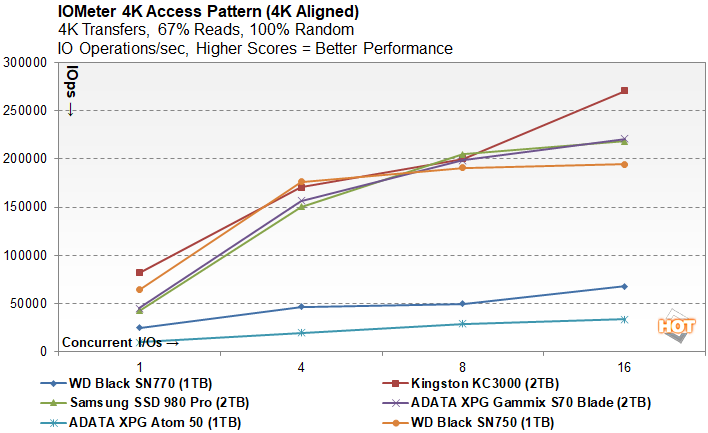
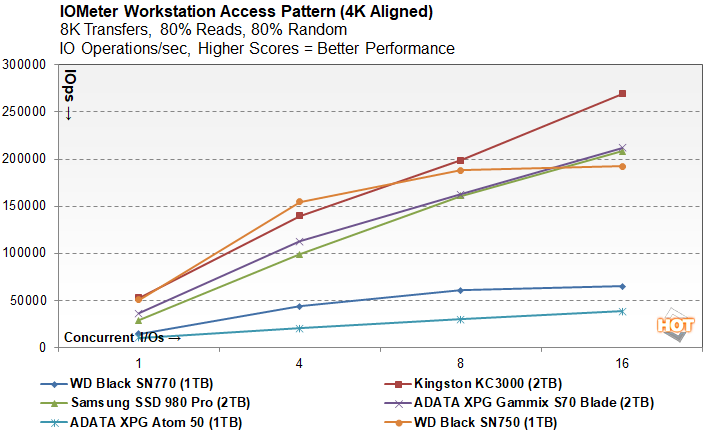
We've got a varied mix of drives here to illustrate the performance differences between older PCIe Gen 3 drives, higher-end Gen 4 drives, and DRAM-less drives. With this particular mix of competitors, the XPG Atom 50 ends up trailing the pack in terms of IOs, especially at the queue depth is increased.

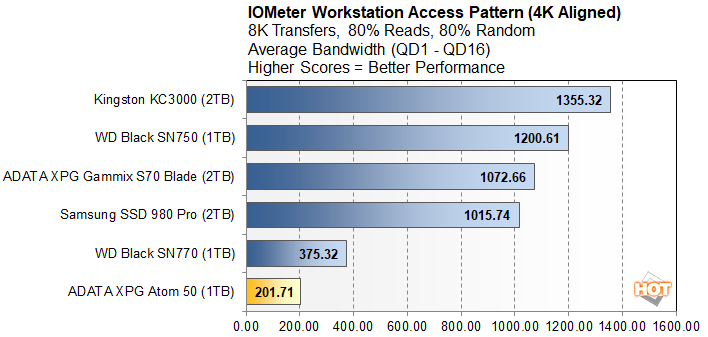
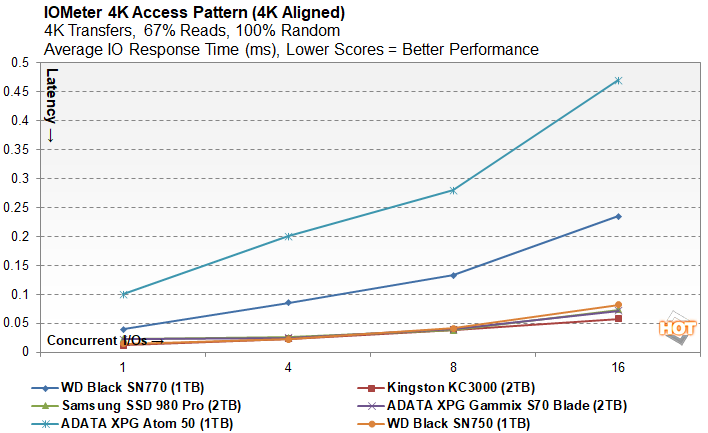

Our latency results also show the higher-end drives offering lower latencies across all queue depths. At QD1, which is most relevant to mainstream, consumer workloads, the deltas separating the drives are relatively small, but the XPG Atom 50 trails here nonetheless.
SiSoft SANDRA 2021
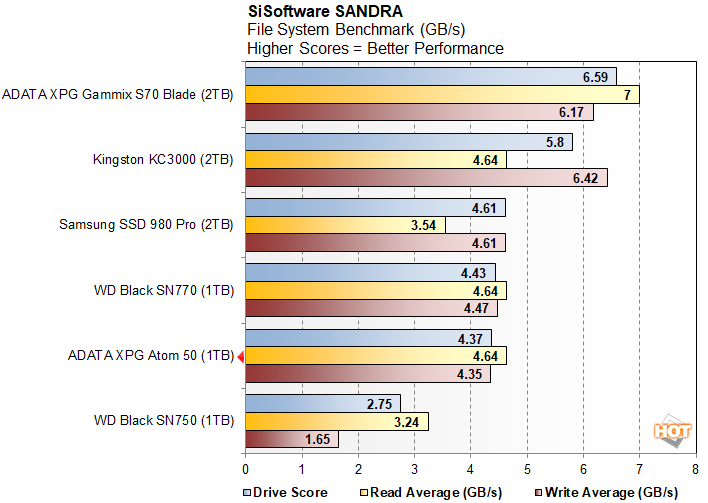
The SANDRA file system benchmark had the XPG Atom 50 clearly outrunning the PCIe Gen 3 WD Black SN750 performing similarly to the also-DRAM-less SN770, but the higher-end drives come out well ahead.
ATTO Disk Benchmark
ATTO is another "quick and dirty" type of disk benchmark that measures transfer speeds across a specific volume length. It measures raw transfer rates for both reads and writes and graphs them out in an easily interpreted chart. We chose .5KB through 64MB transfer sizes and a queue depth of 6 over a total max volume length of 256MB. ATTO's workloads are sequential in nature and measure raw bandwidth, rather than I/O response time, access latency, etc.
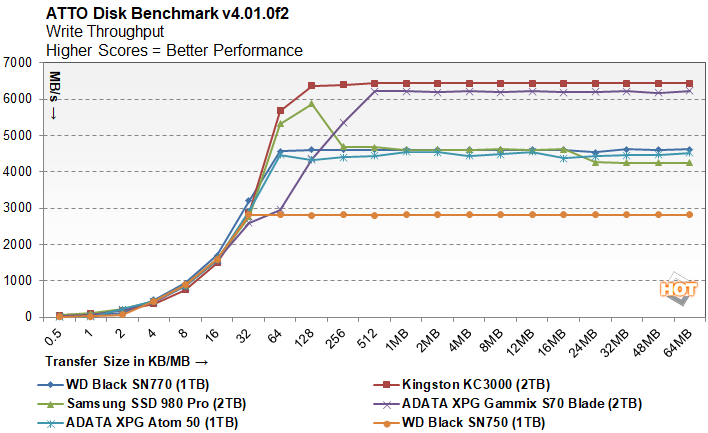
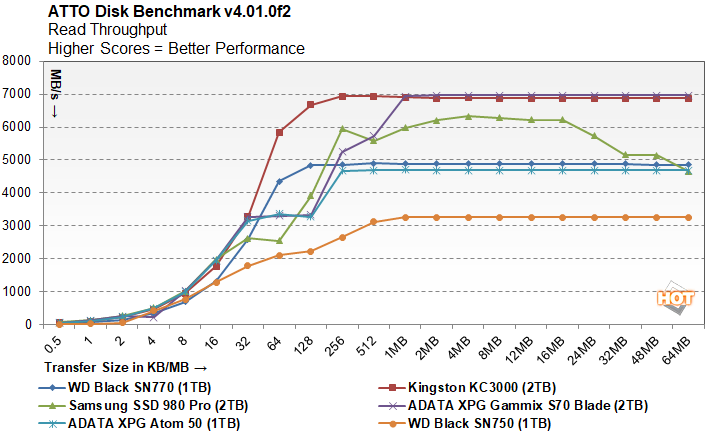
The XPG Atom 50 is rated for 5GB/s reads with 4.5GB/s writes. In ATTO's write test, the drive finishes right in-line with expectations and in the read tests is just barely missed hitting that 5GB/s mark.

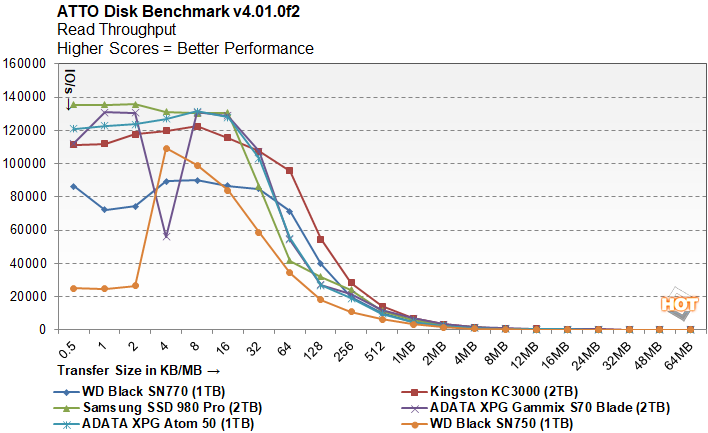
IO performance according to ATTO had the XPG Atom 50 competing well with the other drives we tested. Save for a couple of the very small transfers sizes in the write test, the XPG Atom 50 was right in the mix.
AS SSD Compression Benchmark
Next up we ran the Compression Benchmark built-into AS SSD, an SSD specific benchmark being developed by Alex Intelligent Software. This test is interesting because it uses a mix of compressible and non-compressible data and outputs both Read and Write throughput of the drive. We only graphed a small fraction of the data (1% compressible, 50% compressible, and 100% compressible), but the trend is representative of the benchmark’s complete results.
